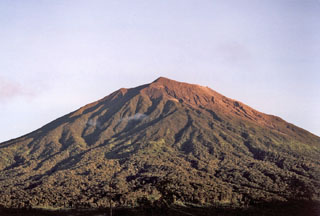Report on Kerinci (Indonesia) — 1 May-7 May 2019
Smithsonian Institution / US Geological Survey
Weekly Volcanic Activity Report, 1 May-7 May 2019
Managing Editor: Sally Sennert.
Please cite this report as:
Global Volcanism Program, 2019. Report on Kerinci (Indonesia) (Sennert, S, ed.). Weekly Volcanic Activity Report, 1 May-7 May 2019. Smithsonian Institution and US Geological Survey.
Kerinci
Indonesia
1.697°S, 101.264°E; summit elev. 3800 m
All times are local (unless otherwise noted)
In a Volcano Observatory Notice for Aviation (VONA) PVMBG noted that local residents reported ashfall from Kerinci in areas 7 km S and NE. According to a news article at least five villages were affected late on 2 May, including Tanjung Bungo, Sangir, Sangir Tengah, Sungai Rumpun, and Bendung Air. A brown ash emission was observed at 1836 on 3 May rising 800 m above the crater rim and drifting ESE. Seismicity was dominated by continuous volcanic tremor and signals indicating gas emissions. The next day at 1708 a brown ash emission rose 300 m and drifted SE. According to the Darwin VAAC an ash emission was observed by a pilot at 0610 on 5 May drifting NE at an altitude of 6.7 km (22,000 ft) a.s.l. The Alert Level remained at 2 (on a scale of 1-4), and tourists were warned to remain outside of the 3-km exclusion zone.
Geological Summary. Gunung Kerinci in central Sumatra forms Indonesia's highest volcano and is one of the most active in Sumatra. It is capped by an unvegetated young summit cone that was constructed NE of an older crater remnant. There is a deep 600-m-wide summit crater often partially filled by a small crater lake that lies on the NE crater floor, opposite the SW-rim summit. The massive 13 x 25 km wide volcano towers 2400-3300 m above surrounding plains and is elongated in a N-S direction. Frequently active, Kerinci has been the source of numerous moderate explosive eruptions since its first recorded eruption in 1838.
Sources: Pusat Vulkanologi dan Mitigasi Bencana Geologi (PVMBG, also known as CVGHM), UZone

